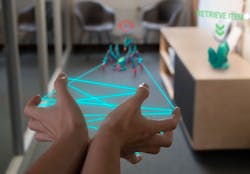For the past decade, progress along the roadmap for augmented reality (AR), virtual reality (VR), and mixed reality (XR) has seemed very incremental in nature, with just enough small evolutions keeping the dream alive.
So, as true evolutions surface, it makes sense to rejoice. Case in point: VividQ, a holographic display technology developer for AR gaming, and Dispelix, a waveguide designer and manufacturer, have come together to design and manufacture a ‘waveguide combiner’ capable of accurately displaying simultaneous variable-depth 3D content within a user’s environment (see video).
Currently available AR devices present images at a fixed distance far from the wearer, well outside of arms’ reach, limiting interaction and leading to vergence accommodation conflict (VAC) and eye strain.
“For mass-market adoption, AR needs to offer consumers an immersive experience that they can use for long periods of time without feeling nauseated or suffering from eye strain. Consumers will be able to buy headsets that are as light as possible, and which give them the ability to seamlessly merge real and digital worlds,” says VividQ CTO Tom Durrant. “Such an experience requires the ability to interact with three-dimensional digital characters and objects within arms’ reach, and others placed in and around their environment (desk, room, or outside world). Holography is the only realistic way to achieve this in a consumer product.”
Better understanding of waveguide combiners
Waveguides give a lightweight and conventional-looking front end for AR headsets and are necessary for widespread adoption. Most available waveguides use pupil replication to capture an image from a small display panel or eyebox and enlarge the image with a grid of copies of the small image in front of the viewer’s eye. While making the AR wearable, ergonomic, and easy to use, small eyeboxes are notoriously difficult to line up with the user’s pupil, resulting in the user’s eye falling off the image.
This arrangement requires precisely fitting headsets to the user. Unfortunately, variations in Inter Pupillary Distance (IPD) between users makes it very difficult to align with the eyebox. Since there is a fundamental tradeoff between the eyebox and the field of view (FOV) in display, this replication allows the optical designer to make the eyebox very small, relying on the replication process to give a big effective image to the viewer, while also maximizing the FOV.
Additionally, waveguides assume incoming light rays are parallel (hence a 2D image), as they require that the light bouncing around within the structure all follows paths of the same length. Adding diverging rays of differing lengths (a 3D image) can be problematic, creating an effect where the user sees multiple partially overlapping copies of the input image all at random distances. Currently, having the eyebox and FOV required for a decent AR experience restricts application to only using 2D display types, which can lead to nausea and eye fatigue without providing a fully immersive experience.The 3D waveguide from VividQ is composed of two elements—a modification of the standard pupil replicating waveguide design and an algorithm to compute a hologram that corrects for distortion due to the waveguide.
Collaborative effort
The collaboration between VividQ and Dispelix enables users to enjoy immersive AR gaming experiences where digital content can be placed in their physical world and they can interact with it naturally and comfortably. The two companies have also announced the formation of a commercial partnership to develop the new 3D waveguide technology towards mass production readiness. This advance enables headset manufacturers to kickstart AR product roadmaps now.For an immersive AR experience, consumers need a sufficient field of view and the ability to focus on 3D images at the full range of natural distances—anywhere from 10 cm to optical infinity, simultaneously—in the same way they do naturally with physical objects. A waveguide combiner is the industry’s favored method of displaying AR images in a compact form factor. This next-generation waveguide and accompanying software are optimized for 3D applications like gaming, which means that consumer brands around the world can unlock the market’s full potential.
The patent-pending 3D waveguide combiner works in harmony with the VividQ’s software, both of which can be licensed by wearable manufacturers in order to build out a wearable product roadmap. VividQ’s holographic display software works with standard games engines like Unity and Unreal Engine, making it very easy for game developers to create new experiences. Dispelix will manufacture and supply the 3D waveguide at scale.
“Wearable AR devices have huge potential all around the world. For applications such as gaming and professional use, where the user needs to be immersed for long periods of time, it is vital that content is true 3D and placed within the user’s environment,” says Dispelix CEO and Cofounder Antti Sunnari. “This also overcomes the issues of nausea and fatigue. We are very pleased to be working with VividQ as a waveguide design and manufacturing partner on this breakthrough 3D waveguide.”
Addressing applications
Gaming is perhaps the biggest current market for AR, which requires users to interact with 3D items at different focal depths and to be able to do so comfortably for an extended period of time, which VividQ’s technology enables. “This breakthrough is particularly timely now in the nascent stages of development of the Metaverse, which is predicated on the ability to experience 3D environments and objects in an easy and intuitive way,” Durrant says. “There are many other applications for AR that also require 3D objects and the freedom to focus naturally, without feeling sick or uncomfortable.”
An AR headset needs to be user-friendly and comfortable to wear for long periods of time. Computer-generated holography achieves this, overcoming the VAC/eye-strain impact of other display technologies.
“Waveguides are popular within the AR industry because they are lightweight and enable you to manufacture an ergonomic device with a compact optical engine. Our waveguide design offers an optimally sized eyebox, so that it is easy to just pick up your headset, stick it on, and start playing without having to spend time adjusting for your head size and pupil position,” he says. “In addition, we can offer a large field of view, combining a large 3D holographic region and an even wider 2D area at the periphery of the display, resulting in a very immersive experience.”
Overcoming the impossible
Accomplishing this goal meant first understanding the limitations and then working out how to work around them. “Once we’d identified that path, our multidisciplinary team of researchers and engineers across optics and software set about solving each one in turn. Instead of seeing this as just an optics issue, our solution is based on hardware and software tuned to work in tandem,” says Durrant.
After the theoretical breakthrough, VividQ was able to prove the theory with an off-the-shelf waveguide. However, to realize the full capability, it needed to work with a partner capable of developing something that worked to its exact specifications, which is where Dispelix excels.
For an untethered AR headset solution, challenges remain around power and compute, which have an impact on comfort, size, and the duration for which a consumer can play with such a device. However, these issues do not have to be overcome in order for AR to start having an impact on gaming. “The first-generation devices can be connected physically to a PC or console, which enables consumers to make greater use of the high computing power available from modern GPUs,” says Durrant. “Looking to subsequent generations, devices will be untethered, allowing consumers to use them around the house and even outside, kickstarting the AR gaming market. We’ve overcome a major technical challenge, so now world-leading OEMs and ODMs can start working with our technology stack to bring compelling products and experiences to market.”



